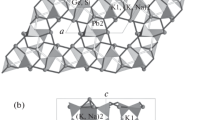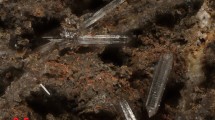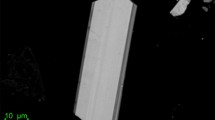Summary
Nesquehonite, MgCO3 · 3H2O, has been observed from Sounion, Lavrion mining district, Greece as a late alteration product in crystals up to 4 mm in size. The structure was refined in P21/n, Z = 4, to R = 0.032 using CCD X-ray single-crystal data of a twinned specimen showing orthorhombic pseudosymmetry. The precise cell parameters a = 7.701(1) Å, b = 5.365(1) Å, c = 12.126(2) Å, β = 90.41(1)°, and V = 501.0(1) Å3 were obtained from a Rietveld refinement of high resolution X-ray powder data with a calculated density of 1.835 gcm−3. The atomic coordinates of the Mg, C and O atoms are in accordance to published data, the hydrogen bond system, however, could now be established on the basis of experimentally determined H positions.
The structure of nesquehonite is characterized by infinite chains along [010], formed by cornersharing MgO6 octahedra. Within the chains, CO3 groups link three MgO6 octahedra by two common corners and one edge, which causes strong distortions of the involved polyhedra. These chains are interconnected via hydrogen bonds only: each Mg atom is coordinated by two H2O ligands, and one free water molecule is situated between the chains. Mean bond lengths are 2.076 Å for Mg-O and 1.283 Å for C–O, the aplanarity of the carboate group is 0.025(3) Å Of the six hydrogen bonds, five are usual ones with O–H⋯O from 2.738(2) Å to 2.820(2) Å the sixth one is found to be bifurcated.
Zusammenfassung
Nesquehonit, MgCO3 · 3H2O, ist aus Sounion, Bergbaugebiet Lavrion, Griechenland als spätes Verwitterungsprodukt in Kristallen bis zu 4 mm Größe beobachtet worden. Die Kristallstruktur wurde in P21/n, Z = 4, anhand von CCD-Röntgen-Einkristalldaten eines Zwillings mit orthorhombischer Pseudosymmetrie zu einem R-Wert von 0.032 verfeinert. Die genauen Zellparameter a = 7,701(1) Å, b = 5,365(1) Å, c = 12,126(2) Å, β = 90,41(4)° und V = 501,0(1) Å3 wurden aus einer Rietveld-Verfeinerung von hochaufgelösten Röntgen-Pulverdaten ermittelt. Die berechnete Dichte ist 1,835 gcm−3. Die Atomkoordinaten der Mg, C und O Atome entsprechen den bereits publizierten Daten, jedoch konnte nun das Wasserstoffbrückensystem anhand von experimentell bestimmten H – Positionen geklärt werden.
Die Struktur von Nesquehonit ist durch unendliche Ketten entlang [010] gekennzeichnet, die aus eckenverknüpften MgO6-Oktaedern gebildet werden. Innerhalb der Ketten verbinden planare CO3-Gruppen drei MgO6-Oktaeder über zwei gemeinsame Ecken und eine Kante und verursachen dadurch eine starke Verzerrung der beteiligten Polyeder. Diese Ketten sind untereinander nur mittels Wasserstoffbrücken verbunden: jedes Mg Atom besitzt zwei H2O-Liganden, und ein freies Wassermolekül liegt zwischen den Ketten. Die mittleren Bindungslängen betragen 2,076 Å für Mg–O und 1,283 Å für C–O, die Aplanarität der Karbonatgruppe ist 0,025(3) Å. Fünf der sechs Wasserstoffbrücken liegen mit O–H · O von 2,738(2) Å bis 2,820(2) Å, im üblichen Bereich, die sechste ist zweifach aufgespalten.
Similar content being viewed by others
Author information
Authors and Affiliations
Additional information
Received October 22, 1999; revised version accepted February 7, 2000
Rights and permissions
About this article
Cite this article
Giester, G., Lengauer, C. & Rieck, B. The crystal structure of nesquehonite, MgCO3 · 3H2O, from Lavrion, Greece. Mineralogy and Petrology 70, 153–163 (2000). https://doi.org/10.1007/s007100070001
Issue Date:
DOI: https://doi.org/10.1007/s007100070001




